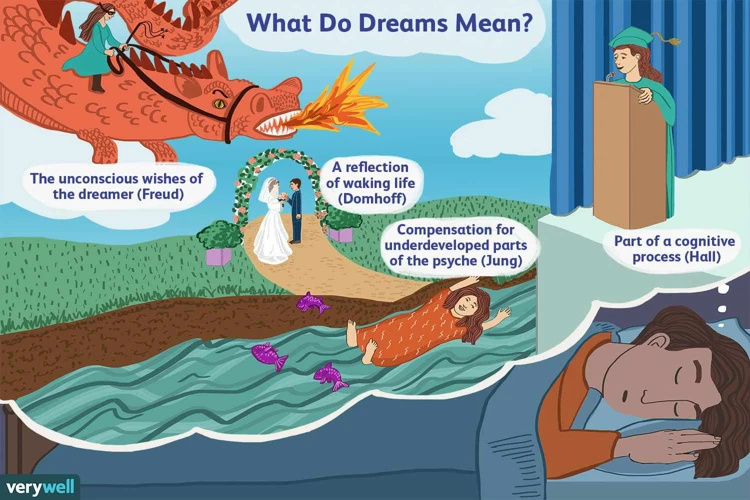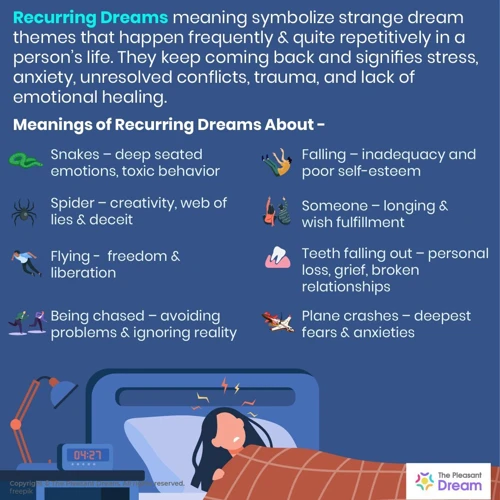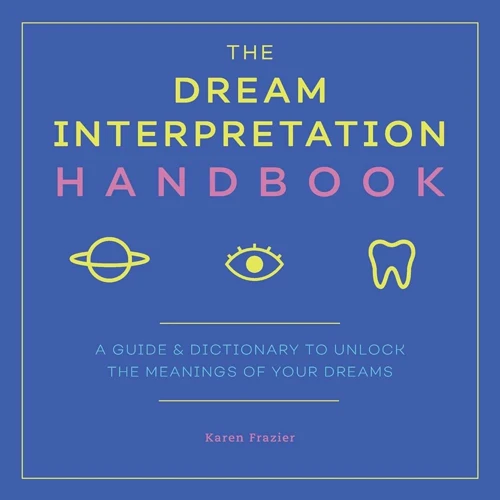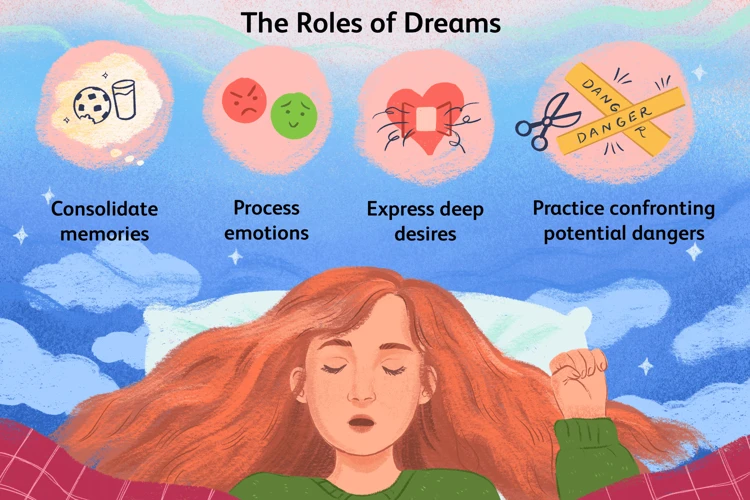Do you ever find yourself waking up with a sense of deja vu, as if you’ve experienced the same dream over and over again? Recurring dreams, a phenomenon that has puzzled and fascinated humans for centuries, hold a significant role in the field of psychology. These dreams, which occur repeatedly, often carry symbolic messages that can provide valuable insights into our subconscious mind. By delving into the psychological interpretations of recurring dreams, we can gain a deeper understanding of ourselves, uncover unresolved issues, and embark on a transformative journey towards personal growth. In this article, we will explore the various types, common themes, and causes of recurring dreams, as well as examine the symbolic language they use. Additionally, we will discuss techniques for analyzing and interpreting these dreams and explore their therapeutic value. So, let’s embark on this intriguing exploration into the role of recurring dreams in psychological interpretation.
Understanding Recurring Dreams

Recurring dreams have long intrigued and puzzled dream researchers, offering a fascinating window into the mysterious workings of the human subconscious mind. Understanding recurring dreams involves delving into their intricate nature, starting with their various theories and definitions. These dreams are characterized by their repetitive occurrence, making them different from other dreams that are fleeting and unique. The types of recurring dreams can vary greatly, ranging from nightmares to mundane scenarios, leaving individuals pondering their symbolic meanings and significance. By unraveling the mysteries behind these dreams, we can begin to unravel the hidden layers of our psyche and gain profound insights into our emotions, fears, and desires.
Definition of Recurring Dreams
Recurring dreams, as the name suggests, refer to dreams that occur repeatedly over a period of time. These dreams stand out from other dreams due to their repetitive nature, often leaving a lasting impression on the dreamer. While the exact definition of recurring dreams varies slightly depending on individual interpretations, they are generally characterized by the recurrence of similar dream content, themes, or scenarios. It’s important to note that recurring dreams are not mere repetitions of the exact same dream, but rather variations of a central theme or storyline that manifest in different ways. Recurring dreams can occur at any age and may persist for weeks, months, or even years. They can vary in intensity and emotional impact, ranging from pleasant and intriguing to distressing and nightmarish. The phenomenon of recurring dreams raises questions about the significance and purpose behind their repetitive occurrence, sparking curiosity and prompting individuals to explore their subconscious mind in search of answers.
Types of Recurring Dreams
Recurring dreams come in various forms and can encompass a wide range of experiences, each with its own unique symbolic significance. Understanding the types of recurring dreams can offer valuable insights into the themes and patterns that appear repeatedly in our subconscious mind.
1. Nightmare Dreams: These dreams are characterized by intense fear, anxiety, and feelings of powerlessness. Nightmare dreams often involve threatening situations, such as being pursued by a monster or trapped in a dangerous scenario. They can be a reflection of unresolved fears or past traumas that continue to haunt us, urging us to confront and overcome our deepest anxieties.
2. Test or Exam Dreams: These dreams often involve being unprepared for an impending test or examination. Whether it’s a school exam or a test in a different context, the common theme is feeling unprepared and overwhelmed. Test dreams may reflect a fear of failure, performance anxiety, or a lack of confidence in one’s abilities. They can serve as a reminder to focus on self-improvement and preparation in waking life.
3. Lost or Stuck Dreams: In these dreams, individuals find themselves lost in unfamiliar places, unable to find their way home or navigate through a confusing maze. There is a sense of being trapped or unable to progress. Symbolically, these dreams may represent a feeling of being lost or uncertain in one’s life circumstances, struggling to find direction or a sense of purpose. They can be a call to explore new possibilities and make choices that lead to personal growth and fulfillment.
4. Repeating Action Dreams: These dreams involve repetitive actions or scenarios, often without resolution. For example, dreaming of being stuck in a continuous loop of performing a task or experiencing the same event repeatedly. These dreams may indicate feelings of being stuck in a rut, trapped in monotonous routines, or dealing with repetitive patterns in one’s life. They can prompt us to break free from stagnant situations and seek new perspectives.
5. Flying Dreams: Flying dreams evoke a sense of freedom, liberation, and empowerment. These dreams often involve soaring through the sky, effortlessly gliding above the ground. Flying dreams can symbolize personal growth, transcendence, or a desire for liberation from constraints. They may inspire individuals to embrace their ambitions, trust their abilities, and take courageous steps towards their goals.
Understanding the different types of recurring dreams can give us clues about the underlying emotions, fears, and desires that are present in our subconscious mind. By paying attention to these recurring themes, we can gain greater self-awareness and use the symbolism of our dreams to navigate our waking lives with purpose and clarity.
Common Themes in Recurring Dreams
While recurring dreams can take on various forms and narratives, there are some common themes that tend to emerge. These recurrent motifs often carry deep symbolic meanings and provide valuable insights into our subconscious mind. One such theme is falling. Falling dreams can evoke a sense of vulnerability, powerlessness, or loss of control. They may reflect a fear of failure, anxiety about a specific situation, or a general sense of insecurity. Another common recurring theme is being chased. These dreams can evoke intense feelings of fear, danger, and a need for escape. Symbolically, being chased may represent avoidance of a certain situation or the inability to confront and overcome personal fears or challenges. Examination dreams are also prevalent, often occurring during times of stress or heightened self-evaluation. These dreams may reflect feelings of inadequacy, fear of judgment, or a need to prove oneself. Other recurrent themes include being naked in public, which may signify vulnerability and a fear of exposing one’s true self, and teeth falling out, which can be associated with issues of self-image, communication, or a fear of aging. Understanding these common themes in recurring dreams allows us to delve deeper into our unconscious desires, fears, and unresolved emotions. By examining the specific symbols and narratives within our dreams, we can gain valuable insight into our own personal journey of self-discovery and growth.
Psychological Interpretation

When it comes to psychological interpretation of recurring dreams, various perspectives offer unique insights. The Freudian perspective focuses on the idea that dreams serve as the keys to unlocking unconscious desires and repressed conflicts. Sigmund Freud believed that recurring dreams often stem from unresolved childhood experiences or unresolved issues in one’s adult life. On the other hand, the Jungian perspective introduced by Carl Jung suggests that recurring dreams tap into a collective unconscious, containing universal symbols and archetypes. According to Jung, these dreams reflect the process of individuation and self-discovery. Modern interpretations build upon these foundational theories, integrating elements of cognitive psychology, neuroscience, and environmental influences. Understanding recurring dreams from a psychological standpoint allows us to delve into the depths of our inner world and explore the underlying motivations and emotions that shape our waking lives.
Freudian Perspective
Sigmund Freud, the renowned psychoanalyst, viewed dreams, including recurring dreams, as a gateway to the unconscious mind. According to Freud’s psychoanalytic theory, dreams serve as a means of wish fulfillment and offer insight into repressed desires and unresolved conflicts. In the Freudian perspective, recurring dreams often revolve around unresolved childhood experiences or repressed sexual desires.
In Freud’s theory of dream interpretation, he introduced the concept of the “manifest content” and the “latent content” of dreams. The manifest content refers to the literal storyline of the dream, while the latent content represents the hidden, symbolic meaning behind it. Freud believed that recurring dreams symbolize unfulfilled wishes or desires from the past, particularly from early childhood experiences.
For example, a recurring dream of falling could be interpreted as a symbol of regressing back to a time when the dreamer felt unsafe or lacked control. Similarly, dreams of being chased may reflect unresolved conflicts or feelings of anxiety. Freud believed that by analyzing the symbols and uncovering the latent content of recurring dreams, individuals could gain insight into their subconscious desires, fears, and conflicts.
It is important to note that while Freud’s theories have had a significant impact on the field of dream analysis, they are not without criticism. Critics argue that his theories rely heavily on sexual and aggressive interpretations, often overlooking other potential interpretations. Nonetheless, the Freudian perspective offers a valuable starting point for understanding recurring dreams and their connection to unconscious desires and conflicts.
Jungian Perspective
In the realm of recurring dream interpretation, the Jungian perspective offers a unique and insightful approach. According to Swiss psychologist Carl Jung, recurring dreams hold important messages from the unconscious mind and are rich in symbolism and archetypal imagery. Jung believed that dreams serve as a pathway to the collective unconscious, a shared repository of ancestral knowledge and experiences. From a Jungian perspective, recurring dreams are seen as an invitation to explore and integrate neglected or suppressed aspects of the self. These dreams often feature recurring symbols or themes that represent universal human experiences and emotions. By analyzing these symbols and themes in the context of an individual’s personal history and life experiences, a greater understanding of the dreamer’s psyche can be gained. According to Jung, recurring dreams may indicate an inner need for growth, self-discovery, or the resolution of inner conflicts. In order to interpret recurring dreams from a Jungian perspective, it is essential to delve into the symbolic language of the dreams, uncover the archetypal elements, and explore their personal and collective significance. This introspective journey can lead to a deeper connection with one’s own psyche, as well as greater self-awareness and personal growth.
Modern Interpretations
Modern interpretations of recurring dreams have expanded beyond the theories and perspectives of Sigmund Freud and Carl Jung, incorporating elements from contemporary psychology and dream research. These modern interpretations recognize that recurring dreams may not necessarily be a direct reflection of unresolved conflicts or repressed desires but can also serve as a reflection of current life experiences and emotions. Psychologists now explore the idea that recurring dreams may be a way for the mind to process and make sense of ongoing events and stresses in one’s life. They may act as a coping mechanism or a means of problem-solving during waking hours. Modern interpretations acknowledge the influence of cultural and individual differences on dream content and meaning. With the emergence of advanced technology and brain imaging techniques, researchers also delve into the neuroscientific aspects of recurring dreams, exploring how neural processes and memory consolidation may contribute to their occurrence. The ever-evolving field of psychology continues to shed light on new dimensions of recurring dreams, offering fresh perspectives and opening up new avenues for interpretation and analysis.
Causes of Recurring Dreams

The causes of recurring dreams can be multifaceted and rooted in various psychological factors. Unresolved psychological issues are often a leading cause, as recurring dreams serve as a manifestation of unresolved conflicts, traumas, or unresolved emotions that we may have pushed aside or repressed. These dreams act as a subconscious attempt to bring these unresolved issues to the forefront of our awareness. Another common cause is traumatic experiences, where recurring dreams can serve as a way for the mind to process and make sense of the trauma, allowing for healing and resolution. Additionally, repetitive patterns in daily life can also trigger recurring dreams, as our subconscious mind seeks to address and resolve patterns or challenges we encounter on a regular basis. By exploring the causes of recurring dreams, we can gain a deeper understanding of ourselves and the inner workings of our psyche.
Unresolved Psychological Issues
Unresolved psychological issues play a significant role in the occurrence of recurring dreams. These dreams often serve as a mirror to our inner conflicts and unresolved emotions, urging us to address and confront them. Here are some key points to consider regarding unresolved psychological issues and their connection to recurring dreams:
- Unresolved Trauma: Traumatic experiences, such as childhood abuse, accidents, or loss, can leave deep emotional scars. When these traumas remain unprocessed and unresolved, they may manifest in recurring dreams. These dreams can be a way for our subconscious mind to process and heal from the traumatic events.
- Unexpressed Emotions: Emotions that we keep bottled up inside – such as anger, grief, or guilt – can find an outlet through recurring dreams. These dreams provide a safe space for our repressed emotions to surface and be acknowledged. By paying attention to the emotions experienced during these dreams, we can gain valuable insights into our emotional well-being and take steps towards their resolution.
- Internal Conflicts: Conflicting desires, values, or beliefs can create internal tension and turmoil. Recurring dreams may reflect these conflicts, featuring scenarios where we are torn between different choices or caught in repetitive patterns of behavior. By exploring the themes and symbols in these dreams, we can gain a deeper understanding of the underlying conflicts and work towards resolving them.
- Unfulfilled Desires: Dreams often serve as a platform where our unfulfilled desires can be expressed and explored. By recurring, these dreams highlight the significance of these desires in our lives. They may inspire us to reflect on our goals, aspirations, and the steps we need to take to bring fulfillment and resolution to our unmet desires.
Understanding and addressing these unresolved psychological issues is crucial for unraveling the meaning behind recurring dreams and moving towards personal growth and healing. It is important to approach these dreams with curiosity, openness, and a willingness to explore the depths of our psyche.
Traumatic Experiences
Traumatic experiences can play a significant role in the manifestation of recurring dreams. When an individual goes through a distressing or traumatic event, such as an accident, abuse, or loss, the impact can be deeply rooted in their subconscious. These unresolved traumas can resurface in the form of recurring dreams, serving as a means for the mind to process and cope with the emotional aftermath. These dreams may vividly depict the traumatic event itself or contain symbolic representations of the associated emotions and fears. In some cases, individuals may experience recurring nightmares that reenact the traumatic experience, causing distress and anxiety. The intensity and frequency of these dreams often correlate with the severity and lasting impact of the trauma. Understanding and addressing these dreams can be an essential step in the healing process for individuals who have experienced significant trauma. Therapy, such as trauma-focused therapy or dream analysis, can help individuals explore the underlying emotions and memories associated with these recurring dreams, facilitating the process of healing and recovery. It is important to remember that trauma is a complex and deeply personal experience, and seeking professional help from a therapist or counselor is highly recommended for those dealing with the effects of traumatic experiences.
Repetitive Patterns in Daily Life
Repetitive patterns in daily life can play a significant role in the occurrence of recurring dreams. These patterns can be mundane habits, routines, or even significant life events that we find ourselves constantly navigating. Repetitive patterns in daily life are like threads that weave through the fabric of our existence, creating a sense of familiarity and rhythm. These patterns can stem from various aspects of our lives, such as work, relationships, or personal habits. For example, someone who experiences a monotonous routine at their job may find themselves having recurring dreams that mirror this repetitive nature. The subconscious mind often uses these repetitive patterns as symbols or metaphors in our dreams, serving as a reflection of the underlying emotions and experiences we have in our daily lives. These dreams can act as a gentle nudge, reminding us to pay attention to certain aspects of our routine or to explore possibilities for change and growth. Analyzing recurring dreams that revolve around repetitive patterns in daily life can help us gain insights into our emotions and thoughts, offering opportunities for self-reflection and personal transformation.
The Symbolic Language of Recurring Dreams

The symbolic language used in recurring dreams provides a rich tapestry of imagery and metaphors that hold deep meaning within our subconscious minds. These dreams often communicate through a complex network of symbols, which require careful interpretation to unlock their true significance. Symbols can take various forms, from objects and animals to people and locations. They may represent aspects of our personality, unresolved emotions, or hidden desires. Interpreting symbolic imagery involves exploring the personal associations we have with these symbols, as well as considering their broader cultural and universal meanings. Additionally, the role of archetypes comes into play, as these recurring symbolic patterns represent universal themes and symbols that tap into the collective unconscious. By closely examining the symbolic language of recurring dreams, we can gain profound insights into our innermost selves and unlock the hidden messages embedded within these enigmatic visions.
Symbols and their Meanings
Symbols play a crucial role in the language of recurring dreams. Symbols and their meanings are key components when it comes to interpreting the hidden messages within these dreams. Every symbol represents something unique and holds significant personal or universal significance. While some symbols may have common interpretations, it’s important to note that their meaning can vary depending on the individual’s personal experiences and cultural background. For example, a snake might represent transformation and renewal for one person, while it may evoke fear and danger for another. To interpret the symbols in recurring dreams, it is essential to carefully analyze the context, emotions, and personal associations attached to each symbol. It can be helpful to keep a dream journal and write down the symbols and their accompanying emotions. Over time, patterns may emerge, providing additional insight into the symbolism. Additionally, exploring the subconscious through practices like free association and dream analysis can aid in unraveling the deeper meanings behind these symbols. By decoding the symbolic language employed in recurring dreams, individuals can unlock profound insights into their unconscious desires, fears, and unresolved issues.
Interpreting Symbolic Imagery
Interpreting symbolic imagery in recurring dreams is a crucial aspect of understanding the messages that the subconscious mind is trying to convey. Symbols serve as a language of their own, layered with personal associations and universal meanings. When analyzing symbolic imagery, it is essential to consider the context in which they appear and the emotions they evoke. Dream symbols can range from common objects like keys or houses to more abstract concepts such as water or fire. Keeping a dream journal can help identify recurring symbols and their potential significance. It is important to recognize that symbols can have both personal and universal interpretations, so it is necessary to reflect on their relevance to individual experiences and cultural contexts. Exploring archetypes can provide valuable insights into deeply rooted patterns of human behavior and psychology. Archetypes are universal symbols that tap into the collective unconscious and can represent common themes like the hero, the shadow, or the wise old man. By analyzing and interpreting the symbolic imagery in recurring dreams, individuals can gain a deeper understanding of their inner world and uncover hidden meanings that can guide personal growth and self-discovery.
The Role of Archetypes
The Role of Archetypes:
1. Universality: Archetypes are deeply ingrained in human consciousness, representing universal patterns and symbols that transcend cultural and individual differences. These archetypal symbols, such as the ‘mother figure’ or the ‘wise old man,’ hold collective meaning and resonate with individuals across different cultures and time periods.
2. Collective Unconscious: Psychologist Carl Jung proposed the concept of the collective unconscious, which contains a reservoir of shared experiences and inherited knowledge. Archetypes are said to emanate from this collective unconscious, shaping our dreams and influencing our behaviors and perceptions.
3. Symbolic Representation: Archetypes serve as powerful symbols in recurring dreams, providing valuable insights into our inner world. They embody fundamental human traits, emotions, and experiences, serving as metaphors that communicate subconscious messages. For example, a recurring dream featuring a ‘shadow’ archetype might signify the individual’s unacknowledged or repressed aspects.
4. Transformation and Integration: Recognizing and understanding archetypes in recurring dreams can facilitate personal growth and transformation. By identifying and working with these archetypal symbols, individuals can gain a greater understanding of their own psyche, reconcile inner conflicts, and integrate different aspects of themselves.
5. Mythological and Cultural Significance: Archetypes often draw from myths, legends, and cultural narratives, carrying a collective significance beyond the individual. These archetypal stories have been passed down through generations, reflecting fundamental human experiences and offering guidance and wisdom.
6. Therapeutic Applications: Exploring archetypes in recurring dreams can be a valuable tool in therapy. Therapists may use techniques such as active imagination or dream analysis to help clients uncover the meaning behind these archetypal symbols, facilitating personal insight and healing.
Understanding the role of archetypes in recurring dreams allows us to tap into the profound wisdom of the collective unconscious and unlock the transformative power of these symbolic representations. By exploring and interpreting these archetypal symbols, we can embark on a journey of self-discovery and personal growth.
How to Analyze and Interpret Recurring Dreams

Analyzing and interpreting recurring dreams requires a systematic approach to unlock their hidden meanings and gain a deeper understanding of their significance. One powerful technique is to keep a dream journal, documenting the details of each dream, such as the setting, characters, and emotions experienced. This not only helps identify patterns and symbols that frequently appear but also aids in identifying the emotions associated with them. Another effective method is to seek professional help, such as consulting with a therapist or dream analyst, who can provide expert guidance and interpretations based on their understanding of dream symbolism and psychological theories. Additionally, individuals can explore various interpretation tools, such as books, online resources, or dream dictionaries, to gain insights into the possible meanings behind recurring dream elements. By applying these techniques, individuals can navigate the intricate realm of recurring dreams and unlock the wealth of knowledge they hold.
Keeping a Dream Journal
Keeping a dream journal is an invaluable tool for analyzing and interpreting recurring dreams. It involves diligently recording the details of your dreams as soon as you wake up. Here are some tips to effectively maintain a dream journal:
- Keep a journal by your bed: Place a notebook or journal and a pen within reach of your bed. This will make it easy to jot down your dreams as soon as you wake up, before they fade from memory.
- Record immediately: Upon waking, take a few moments to recall your dream and write down as many details as possible. Include emotions, settings, people, symbols, and any other significant elements.
- Date and title: Start each dream entry with the date and optionally add a title or a brief description to help you remember the dream later.
- Be consistent: Make an effort to record your dreams regularly, even if you don’t remember them every night. With practice, dream recall can improve.
- Include your feelings: Note your emotions during the dream and upon waking. Emotions play a crucial role in understanding the underlying meanings of recurring dreams.
- Reflect and analyze: Set aside time to review your dream journal regularly. Look for patterns, recurring symbols, and connections between dreams. Reflect on how the dreams relate to your waking life and personal experiences.
By consistently keeping a dream journal, you create a written record of your dreams that allows you to observe trends and gain insights into recurring themes or symbols. This practice enhances your self-awareness and provides a foundation for further interpretation and analysis of your dreams.
Identifying Patterns and Symbols
Identifying patterns and symbols is a crucial step in unlocking the meaning behind recurring dreams. To effectively analyze and interpret these dreams, you need to pay attention to recurring elements and themes that emerge in your dream experiences. One way to identify patterns is by keeping a dream journal. By documenting your dreams regularly, you can track recurring symbols, emotions, and events, allowing you to spot connections and themes that may be hiding beneath the surface. Organizing your dream journal with categories or tags can help you easily identify patterns when reviewing your entries. Another method is creating visual representations of your dreams, such as mind maps or collages, as a way to visually identify recurring symbols and their relationships. Additionally, discussing your dreams with others or joining a dream analysis group can provide different perspectives and insights on common symbols and themes. By actively engaging with your dreams and looking for patterns and symbols, you can unlock the hidden messages and subconscious narratives that recurring dreams may be trying to convey.
Seeking Professional Help
Seeking professional help is a crucial step for individuals who are struggling to analyze and interpret their recurring dreams. Professional dream analysts or therapists specialize in understanding the complexities of the human mind and can provide valuable insights and guidance throughout the dream exploration process. These experts are equipped with extensive knowledge of dream symbolism, archetypes, and psychological theories, enabling them to offer a deeper understanding of the recurring dream’s underlying messages. When seeking professional help, it is important to choose a therapist or dream analyst who specializes in dream interpretation and has experience working with recurring dreams specifically. They will create a safe and non-judgmental space where individuals can openly discuss their dreams, emotions, and personal experiences. These professionals may use various techniques such as dream analysis, talk therapy, and cognitive-behavioral approaches to help clients uncover patterns, symbols, and themes within their recurring dreams. The insights gained from professional help can provide clarity, facilitate personal growth, and aid in resolving psychological conflicts. So, if you find yourself in need, consider reaching out to a qualified professional to navigate the intricate pathways of your recurring dreams.
The Therapeutic Value of Recurring Dreams

Recurring dreams possess a significant therapeutic value that extends beyond their enigmatic nature. These dreams have the potential to serve as powerful tools for personal growth and healing. One of the ways these dreams offer therapeutic benefits is through unconscious problem-solving. As we experience recurring dreams, our subconscious mind is actively working to resolve and process unresolved issues, conflicts, and emotions. This process allows us to gain new perspectives and insights into our challenges, ultimately leading to solutions and resolutions. Recurring dreams provide a space for emotional release and catharsis. By revisiting recurring dreams, we can confront suppressed emotions, fears, and traumas, allowing for a release of pent-up feelings. This emotional catharsis can lead to a sense of relief, emotional healing, and a sense of closure. Finally, recurring dreams also offer opportunities for integration and personal growth. By exploring the symbolism and patterns within these dreams, we can gain a deeper understanding of ourselves, our patterns of behavior, and our relationships. This self-reflection and introspection pave the way for personal growth and self-awareness, enabling us to make positive changes and navigate our lives with greater intention and purpose.
Unconscious Problem-Solving
Unconscious problem-solving is a fascinating aspect of recurring dreams that taps into the untapped potential of the human mind. In these dreams, our subconscious mind takes the reins, working tirelessly to find solutions to unresolved issues and challenges in our waking lives. Unconscious problem-solving occurs when we encounter recurring dreams that revolve around a particular problem or dilemma that we may be facing. These dreams serve as a platform for our minds to explore different scenarios, alternatives, and possibilities that may have eluded us during our conscious waking hours. Our dreams provide a safe space where we can experiment, test out ideas, and work through various emotions without the constraints of societal norms or external pressures. By immersing ourselves in these recurring dreams, we can tap into our innate problem-solving abilities, unlocking new insights and potential solutions that may have been hidden from our conscious awareness. Whether it’s a significant life decision, a complex interpersonal conflict, or a creative challenge, recurring dreams can serve as valuable tools for self-discovery and growth. Embracing these dreams and reflecting upon their messages can lead to newfound clarity, resilience, and a deeper understanding of ourselves and the world around us.
Emotional Release and Catharsis
Emotional release and catharsis play a significant role in the therapeutic value of recurring dreams. These dreams provide a unique opportunity for individuals to release pent-up emotions and achieve a sense of catharsis, or emotional purging. When we experience intense emotions in our waking life, such as grief, anger, or anxiety, they can become suppressed or repressed. Recurring dreams allow these suppressed emotions to surface in a safe and controlled environment, providing an avenue for emotional release. By reliving and processing these emotions within the dream realm, individuals can gain a profound sense of relief and release, ultimately leading to a reduction in emotional distress and an improved sense of well-being. This process of emotional catharsis can be likened to a pressure valve being released, allowing suppressed emotions to flow freely and alleviating the burden they may have placed on the individual’s mental and emotional state. It is important to note that while recurring dreams can facilitate emotional release, they should not be seen as a substitute for professional therapy or support. Seeking guidance from a qualified mental health professional can provide additional tools and support in navigating and processing these emotions.
Integration and Personal Growth
Integration and personal growth are key aspects of recurring dreams, providing individuals with opportunities to reflect, heal, and develop on a deeper level. Integration refers to the process of combining and harmonizing various aspects of our personality, experiences, and emotions. Through recurring dreams, our unconscious mind attempts to bring unresolved issues to the surface, urging us to confront and integrate them into our conscious awareness. These dreams act as catalysts for personal growth by inviting us to explore our inner selves, face our fears, and work through emotional blockages. By engaging with the symbols and themes present in recurring dreams, we can gain greater self-awareness and develop a stronger sense of wholeness. Embracing the messages and lessons within these dreams allows us to evolve and transform, ultimately leading to a more integrated and fulfilling life. It is through this process of integration and personal growth that recurring dreams serve as powerful tools for self-discovery and self-actualization.
Common Recurring Dreams and Interpretations
One of the intriguing aspects of recurring dreams lies in the common themes and scenarios that often manifest. These common recurring dreams capture our attention and curiosity, as they offer a glimpse into universal experiences shared by dreamers worldwide. Falling dreams are among the most frequently reported recurring dreams, symbolizing a loss of control or insecurity in waking life. Being chased dreams often reflect a sense of anxiety or avoidance, representing unresolved issues or a need to confront fears head-on. Another common recurring dream is the examination dream, which signifies feelings of inadequacy or a fear of being judged. Each of these dreams carries its own unique interpretation, serving as a rich tapestry of symbolism that can provide valuable insights into the dreamer’s subconscious mind and emotional landscape.
Falling Dreams
Falling dreams are among the most common recurring dreams experienced by people of all ages. During these dreams, individuals find themselves suddenly plummeting from a great height, often accompanied by a feeling of fear, panic, or helplessness. While the sensation of falling may seem terrifying, the psychological interpretation of these dreams goes beyond literal interpretation. Instead, they often symbolize a lack of control, feelings of insecurity, or a fear of failure in waking life. Falling dreams can also indicate a fear of letting go, whether it be a fear of losing control or a fear of change. These dreams may occur during times of significant transition or when individuals are facing new challenges or uncertainties. It is important to note that the meaning behind falling dreams can vary from person to person, as our individual experiences and emotions shape our dream symbolism. By paying attention to the context and emotions surrounding these dreams, we can gain valuable insights into our subconscious fears and anxieties, allowing us to address and overcome them in waking life.
Being Chased Dreams
Being chased dreams are a common recurring dream theme that has captivated the imagination of dreamers. In these intense and often anxiety-inducing dreams, individuals find themselves in a state of fear as they are pursued by an unknown force or person. The sensation of being chased triggers a primal instinct for self-preservation, heightening the emotional intensity of the dream. These dreams can take on various forms, such as being chased by monsters, animals, or even faceless figures.
The symbolic meaning behind being chased dreams can vary based on the individual’s personal experiences and emotions. For some, being chased represents a sense of vulnerability and powerlessness in the face of challenges or threats in their waking life. It may reflect their feelings of being overwhelmed or pursued by unresolved issues, stressors, or responsibilities.
Additionally, being chased dreams can also symbolize avoidance or running away from something in one’s life. It may be an indication that the dreamer is trying to escape from confronting difficult emotions, past traumas, or uncomfortable situations. The relentless pursuit in these dreams can serve as a metaphor for the persistent nature of these unresolved issues, reminding the dreamer of the need to confront and address them.
It is important to note that the specific details within the dream, such as the identity of the pursuer and the dreamer’s response, can provide additional insight into the interpretation. For instance, if the pursuer is an authority figure, it may represent a fear of judgment or a sense of being under scrutiny.
Understanding and interpreting being chased dreams can be a powerful tool for personal growth and self-reflection. By exploring the underlying emotions and circumstances in these dreams, individuals can gain a deeper understanding of the challenges they face and the steps they need to take to overcome them. It is advisable for those experiencing recurring being chased dreams to keep a dream journal, noting any recurring patterns or symbols, and seek the guidance of a professional if these dreams cause significant distress or impact their daily lives. By unraveling the symbolic language of being chased dreams, individuals can harness the transformative potential they hold and embark on a path towards healing and self-empowerment.
Examination Dreams
Examination dreams, a common recurring dream theme, can evoke a range of emotions from anxiety to pressure. These dreams often reflect our unconscious concerns about being evaluated or judged in our waking lives. Examination dreams typically involve scenarios where individuals find themselves unprepared, lost, or unable to answer questions correctly during an exam. These dreams can symbolize feelings of insecurity, self-doubt, or a fear of failure that extends beyond academic or professional settings. They may mirror situations in which individuals feel scrutinized or questioned in their personal relationships, careers, or other aspects of life. The symbolic language used in examination dreams often highlights the importance of preparation, self-assessment, and the need for self-confidence. These dreams may serve as reminders to address feelings of inadequacy and develop strategies to deal with the pressures of real-life evaluations. Exploring the underlying meanings of examination dreams can provide valuable insights into our anxieties and help us navigate situations where we feel tested or evaluated.
Conclusion
In conclusion, recurring dreams offer a unique and powerful avenue for exploring the depths of our subconscious mind. They serve as doorways to self-discovery, presenting us with symbols and themes that hold personal significance and psychological insights. By understanding the recurring patterns in our dreams, we can make sense of unresolved issues, traumas, and repetitive patterns in our daily lives. Through the analysis and interpretation of these dreams, we can gain a deeper understanding of ourselves and embark on a journey of personal growth and transformation. The therapeutic value of recurring dreams lies in their ability to act as mechanisms for problem-solving, emotional release, and integration. As we navigate the rich landscape of our dreams, we unlock hidden truths and unleash the creative forces residing within us. Therefore, embracing the role of recurring dreams in psychological interpretation can lead us to a greater sense of self-awareness and ultimately pave the path towards a more fulfilling and meaningful life.
Frequently Asked Questions
What causes recurring dreams?
The causes of recurring dreams can vary, but they are often linked to unresolved psychological issues, traumatic experiences, and repetitive patterns in daily life.
Can recurring dreams have different interpretations for different people?
Absolutely! The interpretation of recurring dreams can vary from person to person depending on their unique experiences, emotions, and personal symbolism.
Are recurring dreams more common in certain age groups?
Recurring dreams can occur at any age, but they tend to be more prevalent during times of major life transitions, such as adolescence, early adulthood, and middle age.
Can recurring dreams be a sign of mental health issues?
While recurring dreams themselves are not necessarily a sign of mental health issues, they can sometimes reflect underlying psychological or emotional challenges that may benefit from professional attention.
Is it possible to control or stop recurring dreams?
Controlling or stopping recurring dreams can be challenging. However, exploring their symbolic meanings, processing emotions associated with the dreams, and seeking therapy can potentially alleviate their frequency or intensity.
Do recurring dreams always have symbolic meanings?
Recurring dreams often carry symbolic meanings, but occasionally they may also reflect literal concerns or experiences that require attention or resolution.
Why do some recurring dreams have intense emotional content?
Intense emotional content in recurring dreams can be attributed to their ability to tap into deep-seated emotions, unresolved conflicts, or traumatic experiences that may have a profound impact on one’s well-being.
Can recurring dreams provide insights into one’s personality?
Yes, recurring dreams can provide valuable insights into one’s personality traits, desires, fears, and subconscious thoughts that may not be readily apparent in waking life.
Are recurring dreams always negative or scary?
No, recurring dreams can have positive, neutral, or negative themes. While some dreams may be unsettling or scary, others can be uplifting, inspiring, or indicative of personal growth.
Do recurring dreams have any scientific basis?
While the study of dreams is ongoing, recurring dreams are widely recognized and studied in the field of psychology and are considered to hold significance in understanding the human mind.








